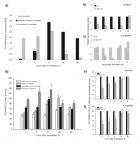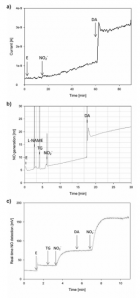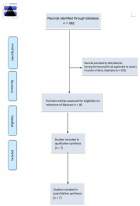Abstract
Research Article
The Effects of Pharmacological Carbonic Anhydrase Suppression on Defence Responses of Potato Leaves To Phytophthora Infestans
Magdalena Arasimowicz-Jelonek* and Jolanta Floryszak-Wieczorek
Published: 03 March, 2017 | Volume 1 - Issue 1 | Pages: 011-025
In this study we proposed carbonic anhydrase (CA) as an important element of basal resistance during the potato (Solanum tuberosum L.)-Phytophthora infestans interaction. We found a different β-CA expression pattern in incompatible vs. compatible systems correlated in time with CA enzyme activity. Resistant potato leaves supplied with dorzolamide (an inhibitor of carbonate CA activity) and challenged with the pathogen showed an elevated nitric oxide (NO) synthesis, which was the most evident during the early phase of NO burst (at 3 hpi) during hypersensitive response (HR). In vitro application of dorzolamide and effective inhibitors of NO synthesis confirmed the implication of CA activity in NO metabolism during potato defense. To clarify how suppression of CA carbonate activity translates into the complexity of NO-related responses leading to potato resistance or susceptibility to an oomycete pathogen we analysed expression of NPR, PR1, and PAL.
Taken together, pharmacological damping of CA activity revealed a functional link between CA and NO-dependent signaling in potato defense against P. infestans manifested by accelerated NO formation and a modified salicylic acid defense pathway. The dorzolamide-mediated effective responses for basal resistance also delayed symptoms of late blight in the susceptible potato cultivar, without overcoming HR formation in the resistant one.
Read Full Article HTML DOI: 10.29328/journal.jpsp.1001002 Cite this Article Read Full Article PDF
References
- Moroney JV, Bartlett SG, Samuelsson G. Carbonic anhydrases in plants and algae. Plant CellEnviron. 2001; 24: 141-153. : https://goo.gl/YTHFVd
- DiMario RJ, Quebedeaux JC, Longstreth DJ, Dassanayake M, Hartman MM, et al. The cytoplasmic carbonic anhydrases βCA2 and βCA4 are required for optimal plant growth at low CO2. Plant Physiol. 2016; 171: 280-293. Ref.: https://goo.gl/nOYqS2
- Badger MR, Price GD. The Role of Carbonic anhydrase in photosynthesis. Annu Rev Plant Physiol Plant Mol Biol. 1994; 45: 369-392. Ref.: https://goo.gl/DxgDJ7
- Reed ML, Graham D. Carbonic anhydrase in plants: distribution, properties and possible physiological roles, In: Progress in phytochemistry, Pergamon Press, Oxford, Reinhold L, Harborne JB, Swaquin T. 1981; 7: 47-94.
- Badger M. The roles of carbonic anhydrases in photosynthetic CO2 concentrating mechanisms. Photosynth Res. 2003; 77: 83-94. Ref.: https://goo.gl/ee26MF
- Tobin AJ. Carbonic anhydrase from parsley leaves. J Biol Chem. 1970; 245: 2656-2666. Ref.: https://goo.gl/G1h6WD
- Fabre N, Reiter IM, Becuwe-Linka N, Genty B, Rumeau D. Characterization and expression analysis of genes encoding alpha and beta carbonic anhydrases in Arabidopsis. Plant Cell Environ. 2007; 30: 617-629. Ref.: https://goo.gl/UQDkoH
- Kaul T, Reddy PS, Mahanty S, Thirulogachandar V, Reddy RA, et al. Biochemical and molecular characterization of stress-induced β-carbonic anhydrase from a C(4) plant, Pennisetum glaucum. J Plant Physiol. 2011; 168: 601-610. Ref.: https://goo.gl/99FF4U
- Pal A, Borthakur D. Tissue-specific differential expression of two β-carbonic anhydrases in Leucaena leucocephala under abiotic stress conditions. J Appl Biotechnol. 2014; 2: 43. Ref.: https://goo.gl/MI0gVx
- Yu S, Zhang X, Guan Q, Takano T, Liu S. Expression of a carbonic anhydrase gene is induced by environmental stresses in Rice (Oryza sativa L.). Biotechnol Lett. 2007; 29: 89-94. Ref.: https://goo.gl/XyFgQz
- Slaymaker DH, Navarre DA, Clark D, Del Pozo O, Martin GB, et al. The tobacco salicylic acid-binding protein 3 (SABP3) is the chloroplast carbonic anhydrase, which exhibits antioxidant activity and plays a role in the hypersensitive defense response. Proc Natl Acad Sci U S A. 2002; 99: 11640-11645. Ref.: https://goo.gl/Jvy8W1
- Wang YQ, Feechan A, Yun BW, Shafiei R, Hofmann A. S-Nitrosylation of AtSABP3 antagonizes the expression of plant immunity. J Biol Chem. 2009; 284: 2131-2137. Ref.: https://goo.gl/mzYzRF
- Arasimowicz-Jelonek M, Floryszak-Wieczorek J, Izbiańska K, Gzyl J, Jelonek T. Implication of peroxynitrite in defence responses of potato to Phytophthora infestans. Plant Pathol. 2015; 65: 754-766. Ref.: https://goo.gl/c13iic
- Abramowski D, Arasimowicz-Jelonek M, Izbianska K, Billert H, Floryszak-Wieczorek J. Nitric oxide modulates redox-mediated defense in potato challenged with Phytophthora infestans. Eur J Plant Pathol. 2015; 143: 237-260. Ref.: https://goo.gl/uU1LN6
- Kato H, Takemoto D, Kawakita K. Proteomic analysis of S-nitrosylated proteins in potato plant. Physiol Plant. 2013; 148: 371-386. Ref.: https://goo.gl/J77aZz
- Chaki M, Valderrama R, Fernández-Ocaña AM, Carreras A, Gómez-Rodríguez MV, et al. High temperature triggers the metabolism of S-nitrosothiols in sunflower mediating a process of nitrosative stress which provokes the inhibition of ferredoxin-NADP reductase by tyrosine nitration. Plant Cell Environ. 2011; 34: 1803-1818. Ref.: https://goo.gl/VHju6f
- Lozano-Juste J, Colom-Moreno R, Leon J. In vivo protein tyrosine nitration in Arabidopsis thaliana. J Exp Bot. 2011; 62: 3501-3517. Ref.: https://goo.gl/mQQ1zj
- Restrepo S, Myers KL, del Pozo O, Martin GB, Hart AL, et al. Gene profiling of a compatible interaction between Phytophthora infestans and Solanum tuberosum suggests a role for carbonic anhydrase. Mol Plant-Microbe Interact. 2005; 18: 913-922. Ref.: https://goo.gl/DkK63s
- Hoang CV, Chapman KD. Biochemical and molecular inhibition of plastidial carbonic anhydrase reduces the incorporation of acetate into lipids in cotton embryos and tobacco cell suspensions and leaves. Plant Physiol. 2002; 128: 1417-1427. Ref.: https://goo.gl/SlsBpI
- Arasimowicz-Jelonek M, Kosmala A, Janus Ł, Abramowski D, Floryszak-Wieczorek J. The proteome response of potato leaves to priming agents and S-nitrosoglutathione. Plant Sci. 2013; 198: 83-90. Ref.: https://goo.gl/MQAc2e
- Janus Ł, Milczarek G, Arasimowicz-Jelonek M, Abramowski D, Billert H, et al. Normoergic NO-dependent changes, triggered by a SAR inducer in potato, create more potent defense responses to Phytophthora infestans. Plant Sci.2013; 211: 23-34. Ref.: https://goo.gl/Jv7QUE
- Aamand R, Dalsgaard T, Jensen FB, Simonsen U, Roepstorff A, et al. Generation of nitric oxide from nitrite by carbonic anhydrase: a possible link between metabolic activity and vasodilation. Am J Physiol Heart Circ Physiol.2009; 297: 2068-2074. Ref.: https://goo.gl/6roFif
- Floryszak-Wieczorek J, Arasimowicz-Jelonek M, Abramowski D, Izbiańska K. Redox-sensing responses in the potato-Phytophthora infestans system. Oxidative stress and cell death in plants: Mechanisms and implications. Abstract book. 2013; 53.
- James WC. An illustrated serioes of assesment keys for plant diseases, their preparation and usage. Can Plant Dis Surv. 1971; 51: 39-65. Ref.: https://goo.gl/nVAfHa
- Floryszak-Wieczorek J, Arasimowicz-Jelonek M, Milczarek G, Janus Ł, Pawlak-Sprada S, et al. Nitric oxide-mediated stress imprint in potato as an effect of exposure to a priming agent. Mol Plant Microbe Interact. 2012; 25: 1469-1477. Ref.: https://goo.gl/WfVyIk
- Floryszak-Wieczorek J, Arasimowicz M, Milczarek G, Jelen H, Jackowiak H. Only an early nitric oxide burst and the following wave of secondary nitric oxide generation enhanced effective defence responses of pelargonium to a necrotrophic pathogen. New Phytol. 2007; 175: 718-730. Ref.: https://goo.gl/kIo5yH
- Ciszewski A, Milczarek G. Electrochemical detection of nitric oxide using polymer modified electrodes. Talanta. 2003; 61: 11-26. Ref.: https://goo.gl/Keq3Bl
- Li X, Hou J, Bai K, Yang X, Lin J, et al. Activity and distribution of carbonic anhydrase in leaf and ear parts of wheat (Triticum aestivum L.). Plant Sci. 2004; 166: 627-632. Ref.: https://goo.gl/fRkpvU
- Chomcznski P, Sacchi N. Single-step method of RNA isolation by acid quanidinium thiocyanate-phenol-chloroform extraction. Anal Biochem. 1987; 162: 156-159. Ref.: https://goo.gl/pPMqaM
- Ye J, Coulouris G, Zaretskaya I, Cutcutache I, Rozen S, et al. Primer-BLAST: a tool to design target-specific primers for polymerase chain reaction. BMC Bioinformatics. 2012; 13: 134. Ref.: https://goo.gl/Ul4fKq
- Zhao S, Fernald RD. Comprehensive algorithm for quantitative real-time polymerase chain reaction. J Comput Biol. 2005; 12: 1047-1064. Ref.: https://goo.gl/1pWkir
- Pfaffl MW. A new mathematical model for relative quantification in real-time RT-PCR. Nucleic Acids Res. 2001; 29: e45. Ref.: https://goo.gl/m6yWxi
- Freytag S, Arabatzis N, Hahlbrock K, Schmelzer E. Reversible cytoplasmic rearrangements precede wall apposition, hypersensitive cell death and defense-related gene activation in potato/Phytophthora infestans interactions. Planta. 1994; 194: 123-135. Ref.: https://goo.gl/UnStrJ
- Orłowska E, Fiil A, Kirk HG, Llorente B, Cvitanich C. Differential gene induction in resistant and susceptible potato cultivars at early stages of infection by Phytophthora infestans. Plant Cell Rep. 2012; 31: 187-203. Ref.: https://goo.gl/J5PgmE
- Floryszak-Wieczorek J, Arasimowicz-Jelonek M. Contrasting regulation of NO and ROS in potato defense-associated metabolism in response to pathogens of different lifestyles. PLoS ONE. 2016; 11: e0163546. Ref.: https://goo.gl/mLeVGU
- Schenk PM, Kazan K, Wilson I, Anderson JP, Richmond T, et al. Coordinated plant defense responses in Arabidopsis revealed by microarray analysis. Proc Natl Acad Sci U S A. 2000; 97: 11655-11660. Ref.: https://goo.gl/2EMtiO
- Frick UB, Schaller A. cDNA micrarray analysis of fusicoccin-induced changes in gene expression in tomato plants. Planta. 2002; 216: 83-94. Ref.: https://goo.gl/ov4jDj
- Polesani M, Desario F, Ferrarini A, Zamboni A, Pezzotti M, et al. cDNA-AFLP analysis of plant and pathogen genes expressed in grapevine infected with Plasmopara viticola. BMC Genomics. 2008; 9: 142. Ref.: https://goo.gl/bdtgfe
- Leitner M, Vandelle E, Gaupels F, Bellin D, Delledonne M. NO signals in the haze: nitric oxide signalling in plant defence. Curr Opin Plant Biol. 2009; 12: 451-458. Ref.: https://goo.gl/NqKiJ4
- Delledonne M, Xia Y, Dixon RA, Lamb C. Nitric oxide functions as a signal in plant disease resistance. Nature. 1998; 394: 585-588. Ref.: https://goo.gl/wLVmaL
- Kolbert Z, Sahin N, Erdei L. Early nitric oxide (NO) responses to osmotic stress in pea, Arabidopsis and wheat. Acta Biol Szeged. 2008; 52: 63-65. Ref.: https://goo.gl/J5LxLN
- Kolbert Z, Ortega L, Erdei L. Involvement of nitrate reductase (NR) in osmotic stress-induced NO generation of Arabidopsis thaliana L. roots. J Plant Physiol. 2010; 167: 77-80. Ref.: https://goo.gl/6XWvX1
- Huang J, Bellin D, Chen J, Fontanesi K, Klainfelder Delledonne M. Novel pathway in formation of NO from nitrite uder normoxic conditions in Arabidopsis. 4th Plant NO Club International Meeting. Edinburgh UK Book of Abstract. 2012.
- Rumeau D, Cuine S, Fina L, Gault N, Nicole M, et al. Subcellular distribution of carbonic anhydrase in Solanum tuberosum L. leaves: Characterization of two compartment-specific isoforms. Planta. 1996; 199: 79-88. Ref.: https://goo.gl/QLY5nW
- Winter H, Robinson DG, Heldt HW. Subcellular volumes and metabolite concentrations in spinach leaves. Planta. 1994; 193: 530-535. Ref.: https://goo.gl/YwlSLv
Figures:

Figure 1

Figure 2

Figure 3

Figure 4

Figure 5

Figure 6

Figure 7

Figure 8
Similar Articles
-
Impact of Calcium Phosphate Nanoparticles on Rice PlantHrishikesh Upadhyaya*,Lutfa Begum,Bishal Dey,P K Nath,S K Panda. Impact of Calcium Phosphate Nanoparticles on Rice Plant. . 2017 doi: 10.29328/journal.jpsp.1001001; 1: 001-010
-
The Effects of Pharmacological Carbonic Anhydrase Suppression on Defence Responses of Potato Leaves To Phytophthora InfestansMagdalena Arasimowicz-Jelonek*,Jolanta Floryszak-Wieczorek. The Effects of Pharmacological Carbonic Anhydrase Suppression on Defence Responses of Potato Leaves To Phytophthora Infestans. . 2017 doi: 10.29328/journal.jpsp.1001002; 1: 011-025
-
Phytochemical content of leaf and stem of Marsilea quadrifolia (L.)Rajangam Udayakumar*,Karikalan Gopalakrishnan. Phytochemical content of leaf and stem of Marsilea quadrifolia (L.). . 2017 doi: 10.29328/journal.jpsp.1001003; 1: 026-037
-
Antagonistic features displayed by Plant Growth Promoting Rhizobacteria (PGPR): A ReviewMohsin Tariq*,Muhammad Noman,Temoor Ahmed,Amir Hameed,Natasha Manzoor,Marriam Zafar. Antagonistic features displayed by Plant Growth Promoting Rhizobacteria (PGPR): A Review . . 2017 doi: 10.29328/journal.jpsp.1001004; 1: 038-043
-
Wild-type Agrobacterium rhizogenes-mediated gene transfer in plants: Agrobacterium virulence and selection of transformantsShu Wei*,Muhammad Abdullah,Ferdinand L Shamalla,Mohammad M Rana. Wild-type Agrobacterium rhizogenes-mediated gene transfer in plants: Agrobacterium virulence and selection of transformants. . 2017 doi: 10.29328/journal.jpsp.1001005; 1: 044-051
-
Effects of Vochysia haenkeana extract on the neuromuscular blockade induced by Bothrops jararaca venom on chick biventer cervicis preparation in vitroYoko Oshima-Franco*,Fernanda Dias da Silva,Natália Tribuiani,Isadora Caruso Fontana Oliveira,Regina Yuri Hashimoto Miura,Rafael S Floriano,Márcio Galdino dos Santos,Sandro Rostelato-Ferreira. Effects of Vochysia haenkeana extract on the neuromuscular blockade induced by Bothrops jararaca venom on chick biventer cervicis preparation in vitro. . 2017 doi: 10.29328/journal.jpsp.1001006; 1: 052-058
-
HBV: Genomic Structure, HBVsAg Isolation and innovative Virotherapy Initiation in the Middle EastAboul-Ata E Aboul-Ata*,Essam M Janahi,I M El-Kalamawy,Kathleen Hefferon,Amal Mahmoud. HBV: Genomic Structure, HBVsAg Isolation and innovative Virotherapy Initiation in the Middle East . . 2017 doi: 10.29328/journal.jpsp.1001007; 1: 059-061
-
Physiological impact of Zinc nanoparticle on germination of rice (Oryza sativa L) seedUpadhyaya H*,Roy H,Shome S,Tewari S,Bhattacharya MK,Panda SK. Physiological impact of Zinc nanoparticle on germination of rice (Oryza sativa L) seed . . 2017 doi: 10.29328/journal.jpsp.1001008; 1: 062-070
-
Effects of Site Factors on the Clonal Growth of Phyllostachys bambusoides f. shouzhu YiXiaohong Gan*,Lijuan Chen,Cuibin Tang,Xia Zhang. Effects of Site Factors on the Clonal Growth of Phyllostachys bambusoides f. shouzhu Yi. . 2017 doi: 10.29328/journal.jpsp.1001009; 1: 071-079
-
Evaluation of genetic diversity in germplasm of paprika (Capsicum spp.) using random amplified polymorphic DNA (RAPD) markersRueda-Puente EO*,Renganathan P,Ruíz-Alvarado C,Hernández-Montiel LG,Prasath Duraisamy. Evaluation of genetic diversity in germplasm of paprika (Capsicum spp.) using random amplified polymorphic DNA (RAPD) markers. . 2017 doi: 10.29328/journal.jpsp.1001010; 1: 080-086
Recently Viewed
-
Pneumothorax as Complication of CT Guided Lung Biopsy: Frequency, Severity and Assessment of Risk FactorsGaurav Raj*,Neha Kumari,Neha Singh,Kaustubh Gupta,Anurag Gupta,Pradyuman Singh,Hemant Gupta. Pneumothorax as Complication of CT Guided Lung Biopsy: Frequency, Severity and Assessment of Risk Factors. J Radiol Oncol. 2025: doi: 10.29328/journal.jro.1001075; 9: 012-016
-
The Police Power of the National Health Surveillance Agency – ANVISADimas Augusto da Silva*,Rafaela Marinho da Silva. The Police Power of the National Health Surveillance Agency – ANVISA. Arch Cancer Sci Ther. 2024: doi: 10.29328/journal.acst.1001046; 8: 063-076
-
A Comparative Study of Serum Sodium and Potassium Levels across the Three Trimesters of PregnancyOtoikhila OC and Seriki SA*. A Comparative Study of Serum Sodium and Potassium Levels across the Three Trimesters of Pregnancy. Clin J Obstet Gynecol. 2023: doi: 10.29328/journal.cjog.1001137; 6: 108-116
-
Chaos to Cosmos: Quantum Whispers and the Cosmic GenesisOwais Farooq*,Romana Zahoor*. Chaos to Cosmos: Quantum Whispers and the Cosmic Genesis. Int J Phys Res Appl. 2025: doi: 10.29328/journal.ijpra.1001107; 8: 017-023
-
Phytochemical Compounds and the Antifungal Activity of Centaurium pulchellum Ethanol Extracts in IraqNoor Jawad Khadhum, Neepal Imtair Al-Garaawi*, Antethar Jabbar Al-Edani. Phytochemical Compounds and the Antifungal Activity of Centaurium pulchellum Ethanol Extracts in Iraq. J Plant Sci Phytopathol. 2024: doi: 10.29328/journal.jpsp.1001137; 8: 079-083
Most Viewed
-
Evaluation of Biostimulants Based on Recovered Protein Hydrolysates from Animal By-products as Plant Growth EnhancersH Pérez-Aguilar*, M Lacruz-Asaro, F Arán-Ais. Evaluation of Biostimulants Based on Recovered Protein Hydrolysates from Animal By-products as Plant Growth Enhancers. J Plant Sci Phytopathol. 2023 doi: 10.29328/journal.jpsp.1001104; 7: 042-047
-
Sinonasal Myxoma Extending into the Orbit in a 4-Year Old: A Case PresentationJulian A Purrinos*, Ramzi Younis. Sinonasal Myxoma Extending into the Orbit in a 4-Year Old: A Case Presentation. Arch Case Rep. 2024 doi: 10.29328/journal.acr.1001099; 8: 075-077
-
Feasibility study of magnetic sensing for detecting single-neuron action potentialsDenis Tonini,Kai Wu,Renata Saha,Jian-Ping Wang*. Feasibility study of magnetic sensing for detecting single-neuron action potentials. Ann Biomed Sci Eng. 2022 doi: 10.29328/journal.abse.1001018; 6: 019-029
-
Pediatric Dysgerminoma: Unveiling a Rare Ovarian TumorFaten Limaiem*, Khalil Saffar, Ahmed Halouani. Pediatric Dysgerminoma: Unveiling a Rare Ovarian Tumor. Arch Case Rep. 2024 doi: 10.29328/journal.acr.1001087; 8: 010-013
-
Physical activity can change the physiological and psychological circumstances during COVID-19 pandemic: A narrative reviewKhashayar Maroufi*. Physical activity can change the physiological and psychological circumstances during COVID-19 pandemic: A narrative review. J Sports Med Ther. 2021 doi: 10.29328/journal.jsmt.1001051; 6: 001-007

HSPI: We're glad you're here. Please click "create a new Query" if you are a new visitor to our website and need further information from us.
If you are already a member of our network and need to keep track of any developments regarding a question you have already submitted, click "take me to my Query."























































































































































